新概念英语1(上)重点知识整理
(完整版)新概念第一册知识点整理,推荐文档
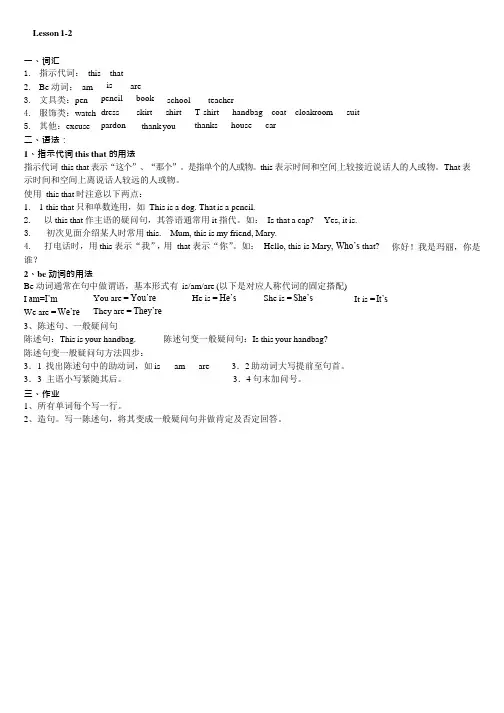
1. I am Rice. (改否定句) 2. His son is a teacher. (改否定句) 3. Mr. Clinton and his wife are busy. (改为否定句) 4. Lily is seven. (改一般疑问句) 5. Are your son a student?(改错)
Lesson 1-2 小测试
Read and choose.
My name Lisa. I
from china.
A. is / am
B. are / is
C. is / are
this a car?
A. am
B. is
C. are
Is this your bag?
A. No, it is.
B. Yes, it isn’t.
2. 非常感谢。
Lesson 3-4
一、词汇 形容词性物主代词: my your his her 名词: umbrella ticket number son 形容词:new good nice 副词:here too 动词:please meet 英语中对男性及女性的称呼: Mr. Sir 二、语法:
Lesson 1-2 小测试 Read and choose. My name Lisa. I
from china.
A. is / am
B. are / is
C. is / are
this a car?
A. am
B. is
C. are
Is this your bag?
A. No, it is.
B. Yes, it isn’t.
B:
?
A: Is this your pencil?
《新概念英语1》1-30复习重点
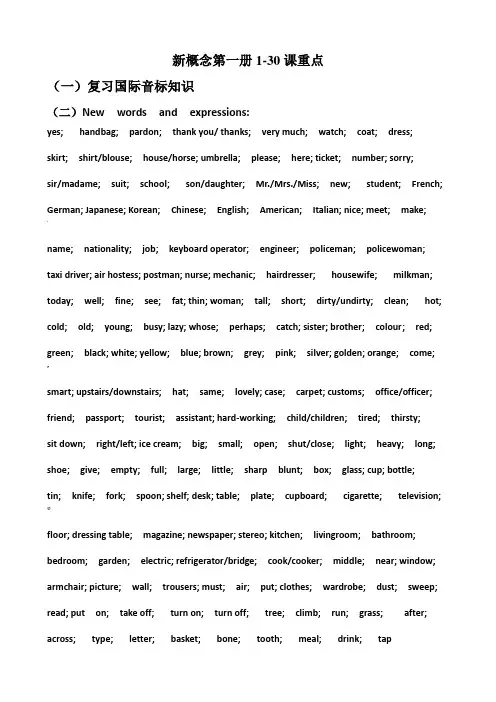
新概念第一册1-30课重点(一)复习国际音标知识(二)New words and expressions:yes; handbag; pardon; thank you/ thanks; very much; watch; coat; dress;skirt; shirt/blouse; house/horse; umbrella; please; here; ticket; number; sorry;sir/madame; suit; school; son/daughter; Mr./Mrs./Miss; new; student; French;German; Japanese; Korean; Chinese; English; American; Italian; nice; meet; make;'name; nationality; job; keyboard operator; engineer; policeman; policewoman; taxi driver; air hostess; postman; nurse; mechanic; hairdresser; housewife; milkman; today; well; fine; see; fat; thin; woman; tall; short; dirty/undirty; clean; hot; cold; old; young; busy; lazy; whose; perhaps; catch; sister; brother; colour; red;green; black; white; yellow; blue; brown; grey; pink; silver; golden; orange; come; ,smart; upstairs/downstairs; hat; same; lovely; case; carpet; customs; office/officer; friend; passport; tourist; assistant; hard-working; child/children; tired; thirsty;sit down; right/left; ice cream; big; small; open; shut/close; light; heavy; long; shoe; give; empty; full; large; little; sharp blunt; box; glass; cup; bottle;tin; knife; fork; spoon; shelf; desk; table; plate; cupboard; cigarette; television; @floor; dressing table; magazine; newspaper; stereo; kitchen; livingroom; bathroom;bedroom; garden; electric; refrigerator/bridge; cook/cooker; middle; near; window;armchair; picture; wall; trousers; must; air; put; clothes; wardrobe; dust; sweep;read; put on; take off; turn on; turn off; tree; climb; run; grass; after;across; type; letter; basket; bone; tooth; meal; drink; tap。
新概念英语第一册重要知识详解笔记
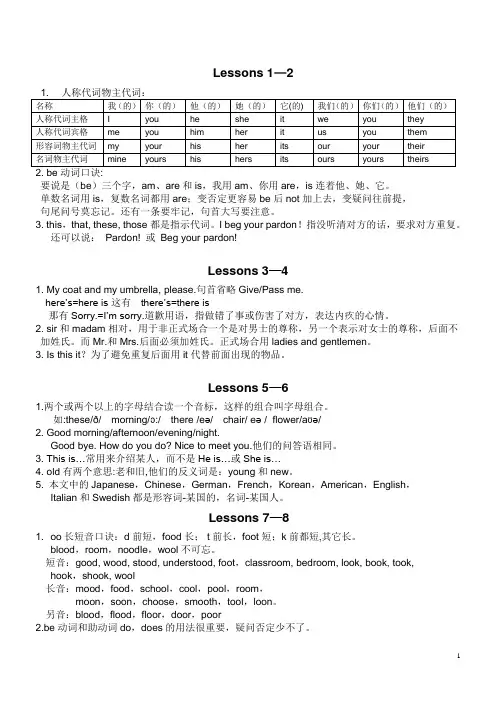
Lessons 1—2要说是(be)三个字,am、are和is,我用am、你用are,is连着他、她、它。
单数名词用is,复数名词都用are;变否定更容易be后not加上去,变疑问往前提,句尾问号莫忘记。
还有一条要牢记,句首大写要注意。
3. this,that, these, those都是指示代词。
I beg your pardon!指没听清对方的话,要求对方重复。
还可以说:Pardon! 或Beg your pardon!Lessons 3—41. My coat and my umbrella, please.句首省略Give/Pass me.here’s=here is这有there’s=there is那有Sorry.=I’m sorry.道歉用语,指做错了事或伤害了对方,表达内疚的心情。
2. sir和madam相对,用于非正式场合一个是对男士的尊称,另一个表示对女士的尊称,后面不加姓氏。
而Mr.和Mrs.后面必须加姓氏。
正式场合用ladies and gentlemen。
3. Is this it?为了避免重复后面用it代替前面出现的物品。
Lessons 5—61.两个或两个以上的字母结合读一个音标,这样的组合叫字母组合。
如:these/ð/ morning/ɔ:/ there /eə/ chair/ eə / flower/aʊə/2. Good morning/afternoon/evening/night.Good bye. How do you do? Nice to meet you.他们的问答语相同。
3. This is…常用来介绍某人,而不是He is…或She is…4. old有两个意思:老和旧,他们的反义词是:young和new。
5. 本文中的Japanese,Chinese,German,French,Korean,American,English,Italian和Swedish都是形容词-某国的,名词-某国人。
新概念英语第一册各课语法知识汇总
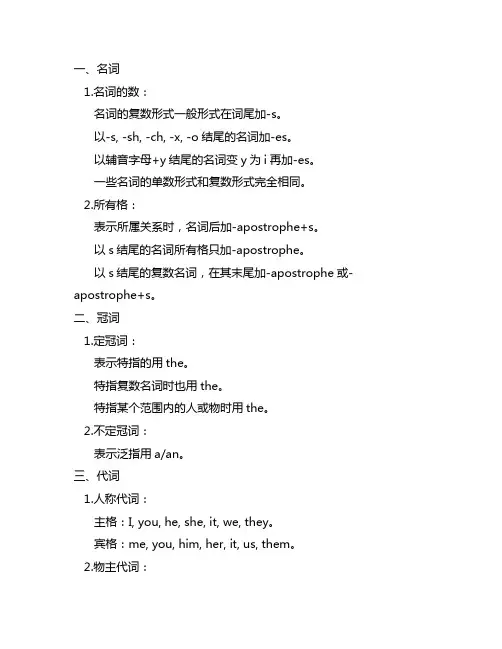
一、名词1.名词的数:名词的复数形式一般形式在词尾加-s。
以-s, -sh, -ch, -x, -o结尾的名词加-es。
以辅音字母+y结尾的名词变y为i再加-es。
一些名词的单数形式和复数形式完全相同。
2.所有格:表示所属关系时,名词后加-apostrophe+s。
以s结尾的名词所有格只加-apostrophe。
以s结尾的复数名词,在其末尾加-apostrophe或-apostrophe+s。
二、冠词1.定冠词:表示特指的用the。
特指复数名词时也用the。
特指某个范围内的人或物时用the。
2.不定冠词:表示泛指用a/an。
三、代词1.人称代词:主格:I, you, he, she, it, we, they。
宾格:me, you, him, her, it, us, them。
2.物主代词:形容词性物主代词:my, your, his, her, its, our, their。
名词性物主代词:mine, yours, his, hers, its, ours, theirs。
3.指示代词:this, that, these, those。
4.不定代词:some, any, no, every, each, many, much, few, little。
四、形容词1.形容词的用法:在名词前作定语。
在系动词之后作表语。
2.比较级和最高级:比较级:比较两者时,用比较级。
最高级:表示三者或三者以上之间的比较。
五、动词1.动词的三单形式:一般情况,动词第三人称单数在末尾加-s。
以辅音字母加y结尾的动词变y为i再加-es。
直接在词尾加-es的动词。
2.动词的现在进行时:am/is/are+动词的现在分词。
3.行为动词的过去式:动词过去式变化规则有规则动词和不规则动词。
六、副词1.副词的用法:修饰动词、形容词、副词。
表示时间、地点、原因、目的等。
2.比较级和最高级:副词比较级和最高级的构成。
七、介词1.介词的基本用法:表示方位、时间、原因、目的等。
新概念第一册每课知识点整理
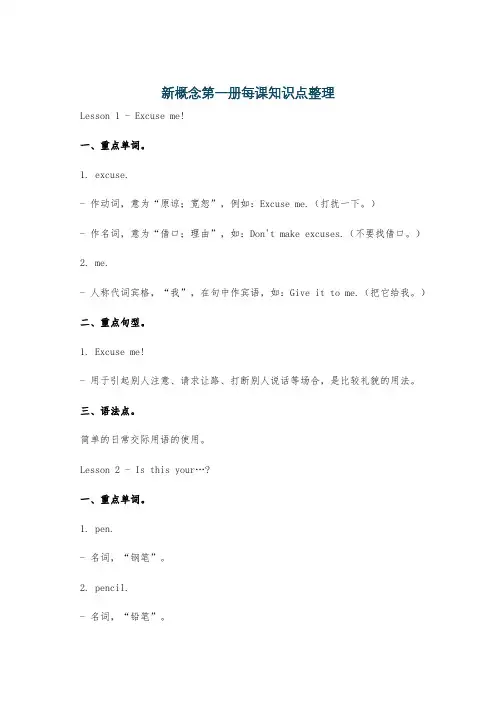
新概念第一册每课知识点整理Lesson 1 - Excuse me!一、重点单词。
1. excuse.- 作动词,意为“原谅;宽恕”,例如:Excuse me.(打扰一下。
)- 作名词,意为“借口;理由”,如:Don't make excuses.(不要找借口。
)2. me.- 人称代词宾格,“我”,在句中作宾语,如:Give it to me.(把它给我。
)二、重点句型。
1. Excuse me!- 用于引起别人注意、请求让路、打断别人说话等场合,是比较礼貌的用法。
三、语法点。
简单的日常交际用语的使用。
Lesson 2 - Is this your…?一、重点单词。
1. pen.- 名词,“钢笔”。
2. pencil.- 名词,“铅笔”。
3. book.- 名词,“书”。
4. watch.- 名词,“手表”;也可作动词,“观看”,如:watch TV(看电视)。
二、重点句型。
1. Is this your pen?- 这是一般疑问句,其结构为“be动词(is/are等)+主语+其他”,回答可以是“Yes, it is.”或者“No, it isn't.”三、语法点。
1. 一般疑问句的构成与回答。
2. 指示代词this的用法,用来指代离说话者较近的人或物。
Lesson 3 - Sorry, sir.一、重点单词。
1. umbrella.- 名词,“雨伞”。
2. please.- 副词,用于请求别人做某事时表示礼貌,如:Please open the window.(请打开窗户。
)二、重点句型。
1. Is this your umbrella?- 同Lesson 2中的一般疑问句结构。
2. Sorry, sir.- “sorry”表示歉意,“sir”是对男性的尊称。
三、语法点。
1. 继续巩固一般疑问句。
2. 尊称“sir”的用法。
Lesson 4 - Is this your…?一、重点单词。
新概念第一册每一课重点的总结1
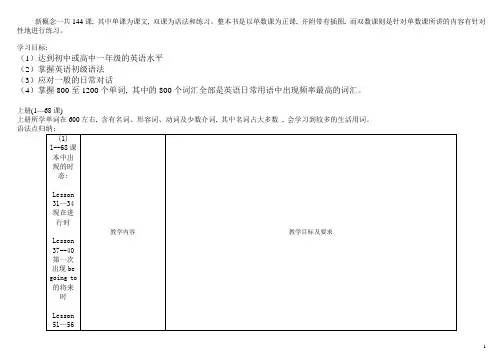
新概念一共144课, 其中单课为课文, 双课为语法和练习。
整本书是以单数课为正课, 并附带有插图, 而双数课则是针对单数课所讲的内容有针对性地进行练习。
学习目标:
(1)达到初中或高中一年级的英语水平
(2)掌握英语初级语法
(3)应对一般的日常对话
(4)掌握800至1200个单词, 其中的800个词汇全部是英语日常用语中出现频率最高的词汇。
上册(1—68课)
上册所学单词在600左右, 含有名词、形容词、动词及少数介词, 其中名词占大多数, 会学习到较多的生活用词。
中册(69—106课), 大约有300单词, 包含名词、动词、形容词、副词、介词, 其中所学的动词和副词会有所增加。
课文中出现的时态有:
Lesson 67—76 为一般过去式
Lesson 83—90 为现在完成时
Lesson 91—96 为一般将来时
下册(107—144课), 大约有300个单词
1、语法点归纳:
2、L107-108形容词的比较级, 最高级
3、L117-118时间状语从句和过去进行时
4、L121-122定语从句
5、L119-120 过去完成时
6、L139-140宾语从句
7、L141-144被动语态。
新概念英语第一册语法总结(上)[八种时态]
新概念英语第一册语法总结(上)[ 八种时态] 一.时态:一般现在时,现在进行时,一般过去时,现在完成时,一般将来时,过去进行时,过去完成时,过去将来时1. 一般现在时表示一般性,经常性的动作或一般性事实。
含有be 动词的句子He is a teacher.The girl is very beautiful.Tim and Jack are students.★变疑问句将be 动词移到句首Is he a teacher?Is the girl very beautiful?Are Tim and Jack students?★变否定句在be 动词后面加notHe is not a teacher.The girl is not very beautiful.Tim and Jack are not students.★肯定回答及否定回答Yes, he is. No, he is not.Yes, she is. No, she is not.Yes, they are. No, they are not.不含有动词的句子,即含有一般动词的句子第三人称单数及单数名词He likes books.She likes him.The dog likes bones.★变疑问句在句首加does, 动词变为原型Does he like books?Does she like him?Does the dog like bones?★变否定句在主语及动词之间加doesn’t动, 词变为原型He doesn ’t like books.She doesn ’t like him.The dog doesn ’t like bones.★肯定回答及否定回答:Yes, h e does. No, he doesn ’ t.Yes, she does. No, she doesn ’tYes, it does. No, it doesn ’t.注意:第三人称单数形式一般在动词后面加S,不要和名词复数混淆,变否定句或疑问句时名词复数没有任何变化。
新概念英语第一册重点词汇和语法(完整版)
新概念英语第一册语法总结1-4 一般疑问句:1-2 一般疑问句肯定回答 3-4 一般疑问句否定回答5-14 特殊疑问句15-16 一般疑问句复数17-18 特殊疑问句复数19-20 名词单数21-24 不定代词。
双宾结构25-28 there be 句型,介词用法29-30 祈使句31-36 现在进行时,there be 句型分析,介词复习37-40 一般将来时, be going to41-42不可数名词,量词的用法43-46 情态动词 can47-50 一般现在时55-56 频度副词57-58 时间59-60复习不可数名词,量词的用法61-64 must 用法65-66 时间表达法:直接,间接,反身代词,情态动词复习67-72 一般过去时主系表结构73-75 一般过去时主谓宾结构77-78 情态动词的否定疑问句,时间介词79-80 need must 情态动词81-82 have –had83-84 现在完成时进行时,将来时对比85-86 have been to / have gone to87-88否定疑问句89-90 may 情态动词91-94 will 一般将来时过去/现在/将来95-96 had better97-98 伴随状语,名词性物主代词99-100 宾语从句101-102 直接引语,间接引语,103-104 too, very, enough105-106动词不定式107-112 形容词的比较级,最高级113-114 否定,肯定倒装115-116 不定代词117-118 时间状语从句,过去进行时119-120 过去完成时121-124 定于从句125-126 must / have to127- 132 情态动词表推测133-136直接引语,间接引语,137-138 条件状语从句139-140宾语从句141-144 被动语态Lesson 1 Excuse me1. Words1) excuse (1)重音(2)与sorry 的区别(3)Excuse 用的不同场景a. 请别人让路b. 引起别人的注意c. 打断别人的谈话d. 可以当n. 借口 eg. No excuse. 别找借口,没有借口。
新概念1知识点
新概念1知识点一、词汇。
1. 基础词汇。
- 数字:one, two, three等,要掌握数字的拼写、读音以及基本的数学运算表达,如“two plus three is five”(二加三等于五)。
- 家庭成员:father, mother, son, daughter, brother, sister等,学会描述家庭关系,例如“My father is a teacher”(我的父亲是一名教师)。
- 颜色:red, blue, green, black, white等,能够用颜色描述物品,如“This pen is blue”(这支笔是蓝色的)。
- 日常用品:pen, pencil, book, bag, desk, chair等,可用于描述周围环境或个人物品,如“There is a book on the desk”(桌子上有一本书)。
2. 动词短语。
- 起床:get up,例如“I get up at seven o'clock every morning”(我每天早上七点起床)。
- 去上学:go to school,如“He goes to school by bike”(他骑自行车去上学)。
- 吃(饭):have/eat,“I have breakfast at home”(我在家吃早饭)。
3. 方位介词。
- in:表示在……里面,如“There is a cat in the box”(盒子里有一只猫)。
- on:表示在……上面(表面接触),“The book is on the table”(书在桌子上)。
- under:表示在……下面,“The ball is under the chair”(球在椅子下面)。
二、语法。
1. 一般现在时。
- 概念:表示经常发生的动作或存在的状态。
- 结构:- 主语是第三人称单数(he/she/it等)时,动词要加 -s或 -es。
例如“He likes reading books”(他喜欢读书)。
新概念第一册语法知识点汇总(完美版)
新概念第一册1-2、3-4一、一般疑问句1. 定义、可以用Yes或No来回答的问句2. 形式:① Be+主语 +......?eg: Are you a student?②情态动词(Can)+ 主语+ 动词原形+……?eg: Can you speak English?③助动词(Do, Does)+ 主语+ 动词原形+......?eg: Do you like English?3. 口诀:①调:调换句子主语和Be 动词以及情态动词的位置。
(若没有be动词或情态动词,则根据主语的人称助动词,并提至句首)②改:改大小写;把第一人称改第二人称;即:I→you,our→your,my→your,am→are,we→you③把句号改成问号4. 回答:肯定回答:Yes, 主语+ be动词(is,am,are) / can / do(do,does).否定回答:No, 主语+ be动词(is,am,are) / can / do(do,does) + not.5-6二、选择疑问句1. 定义:选择疑问句是指提供两种或多种情况供对方选择的疑问句。
选项之间要用连词“or”来连接。
2. 构成:一般疑问句+ or + 选择部分+?例:Are you a doctor or a teacher? 你是一个医生还是教师?Does he like this or that? 他喜欢这个还是喜欢那个?Is that coffee yours or hers? 这咖啡是你的还是她的?注:有时候选择部分会用“or not”来表示例:Are you ready or not (ready) ? 你准备好没有?Do you like the film or not? 你喜不喜欢这部电影?7-8、11-12、13-14三、特殊疑问句1. 含义:以特殊疑问词开头的疑问句。
2. 构成:特殊疑问词+一般疑问句+?3. 特殊疑问词总结:(1) what 什么(职业,姓名等)what day 星期几What day is it today? 几天星期几?what size 多大尺码What size are your shoes? 你的鞋码多大?what time 什么时间What time is it now? 现在几点了?what colour 什么颜色What color is your schoolbag? 你的书包是什么颜色?(2) when 什么时候(就时间提问)When will you visit Beijing? 你什么时候去北京玩?(3) where 什么地方(就地点提问)Where is your hometown? 你的家乡在哪?(4) who 谁(问人的身份,姓名等)Who is the girl in red dress? 穿着红裙子的女生是谁?(5) whose 谁的(whose + n.)Whose book is this?这是谁的书?(6) which 哪一个;哪些Which one is your sister ? 哪一个是你姐姐?(7) why 为什么(就原因提问,常用because回答)Why did you break the window?你为什么要打破窗户?(8) how 怎么样How do you go to school? 你怎么去学校?how many多少(提问可数名词数量)How many books do you have ?你有几本书?how much 多少(提问不可数名词数量)How much water is there in the glass?玻璃杯里有多少水?how much 多少钱(提问价格)How much is the ruler? 这把尺子多少钱?how old 几岁(提问年龄)How old are you? 你多少岁了?how long 多长(提问长度)How long is this ruler? 这把尺子有多长?多长时间(时间持续多久)How long do you go to school? 你去学校要多长时间?how often 多久一次(提问频率既单位时间发生多少次)how soon (还要多久时间才能开始或结束)How soon will he come back? 他多久才能回来?how heavy(提问有多重)How heavy is the luggage?这个行李箱有多重?9-10四、祈使句1. 定义:用于表达命令、请求、劝告、警告等的句子叫做祈使句。
- 1、下载文档前请自行甄别文档内容的完整性,平台不提供额外的编辑、内容补充、找答案等附加服务。
- 2、"仅部分预览"的文档,不可在线预览部分如存在完整性等问题,可反馈申请退款(可完整预览的文档不适用该条件!)。
- 3、如文档侵犯您的权益,请联系客服反馈,我们会尽快为您处理(人工客服工作时间:9:00-18:30)。
Lesson 1~2 Excuse me!高频词汇&短语:1. excuse me 打扰,对不起2. yes? 是的,什么事?3. handbag n. (女用)手提包4. pardon int. 原谅,请再说一遍5. thank you 谢谢你(们)经典句型:1. Is this your handbag? 这是你的手提包吗?2. I beg your pardon? 对不起,请再说一遍?3. Thank you very much. / Thanks a lot. / Many thanks. 非常感谢。
不用谢。
4. Not at all. / You are welcome. /It’s my pleasure.重点语法:1. 形容词性物主代词:你的(your),我的(my),他的(his),她的(her),它的(its),我们的(our), 你们的(your), 他们的(their),用在名词前。
她是she is=she’他是he is=he’s,你是you are=you’re,2. be动词:我是I am=I’m,他们是they s, 它是it is=it’s, 我们是we are=we’re, 你们是you are=you’re,are=they’re.3. 一般疑问句:be动词+主语+其他成分?肯定回答:Yes, 主语+be;否定回答:No, 主语+be+ not.实用对话:1. --打扰一下!Excuse me!--什么事?Yes?2. --这是你的手表吗?Is this your watch?--对不起,请再说一遍。
Pardon?/ I beg your pardon?Lesson 3~4 Sorry, Sir.高频词汇&短语:1. umbrella n. 伞2. suit n. 一套衣服3. sir n. 先生4. daughter n. 女儿5. number five 五号经典句型:1. Here is your umbrella. 这是你的雨伞。
2. Is this your ticket? 这是你的票吗?重点语法:含有be动词的否定句在be动词后面加not:is not = isn’t, are not = aren’t, am not没有缩写实用对话:1. --请把我的大衣和伞拿给我。
My coat and umbrella please.--给你。
Here you are.2. --这不是我的雨伞。
This is not my umbrella.--对不起,先生。
Sorry, sir.Lesson 5~6 Nice to meet you高频词汇&短语:1. good morning/afternoon/evening/night 早上好/中午好/晚上好/晚安2. in the morning/afternoon/evening 在早上/中午/晚上3. Nice to meet you. 见到你很高兴。
4. new student 新学生5. make n. (产品的)牌号经典句型:这是…(介绍某人时)1. This is… 2. What make is it? 它是什么牌子的?重点语法:不定冠词(a, an):表示一个时,若修饰的名词为以元音音标开头则用an,如:an umbrella,其余全用a,如:a university。
第一个字母都是元音u,但是umbrella的第一个音节为[?],元音,所以用an;而university的第一个音节发[j],不是元音,所以用a。
实用对话:--这是汉斯,他是德国人。
This is Hans, he is German.--汉斯,见到你很高兴。
Hans, Nice to meet you.Lesson 7~8 Are you a teacher?高频词汇&短语:1. nationality n. 国籍2. keyboard operator 电脑操作员3. job n. 工作4. engineer n. 工程师经典句型:1. What’s your nationality? = What nationality are you? = Where are you from? =Where do you come from? 你的国籍是什么?/你来自哪里?你是…吗?(后可加职业/性别/国籍等)2. Are you…?你是做什么工作的?3. What’s your job? = What do you do? = What are you?重点语法:特殊疑问句:特殊疑问句是不能用yes或no来回答的,其形式为:特殊疑问词+一般疑问句。
特殊疑问词有:who谁,which哪个,what什么,whose谁的,how如何等。
实用对话:--这是汉斯,他是德国人。
This is Hans, he is German.--汉斯,见到你很高兴。
Hans, Nice to meet you.Lesson 9~10 How are you today?高频词汇&短语:1. hello int. 喂,你好2. today n. 今天3. well adj. 身体好4. fine adj. 美好的,晴朗的5. thanks int. 谢谢6. goodbye int. 再见7. see v. 看见8. fat adj. 胖的→ thin adj. 瘦的9. woman n. 女人→ man n. 男人10. tall adj. 高的→ short adj. 矮的11. dirty adj. 脏的→ clean adj. 干净的的12. hot adj. 热的→ cold adj. 脏的13. old adj. 老的→ young adj. 年轻的14. busy adj. 忙的经典句型:1. How do you do? 初次见面非常高兴。
2. How are you today? 你今天好吗?3. Nice to see you. / Nice to meet you. 很高兴见到你。
重点语法:形容词的用法1. 放在名词或代词前面,作定语,如: a sunny day 一个晴天2. 放在系动词的后面,作句子的表语,如:The room is dirty. 房间是脏的。
实用对话:1. --你好吗?How are you?--我很好,谢谢。
你呢?I’m fine. Thanks. And you?2. --很高兴见到你。
Nice to meet you.--我也很高兴见到你。
Nice to meet you, too.Lesson 11~12 Is this your shirt?高频词汇&短语:1. whose pron. 谁的2. blue adj. 蓝色的;n. 蓝色white adj. 白色的;n. 白色3. perhaps adv. 大概4. catch v. 抓住5. father n. 父亲→ mother n. 母亲6. blouse n. 女衬衫7. sister n. 姐,妹→ brother n. 兄,弟8. tie n. 领带经典句型:1. Whose shirt is this? 这是谁的衬衫?2. This is my shirt. 这是我的衬衫。
3. Here you are. 给你。
重点语法:形容词性所有格表格主格I you he she they we it人名物主代词my your his her their our its人名’s实用对话:--这是谁的衬衫?Whose shirt is this?--这是我的衬衫。
This is my shirt.--给你,接住。
Here you are. Catch.--谢谢。
Thanks.Lesson 13~14 A new dress高频词汇&短语:1. colour n. 颜色(美式拼法:color)2. green adj. 绿色的;n. 绿色3. come v. 来→ go v. 去4. upstairs adv. 往、向楼上→ downstairs adv. 往、向楼下5. smart adj. (指衣服等)漂亮的,时髦的(英式英语);聪明的(美式英语)6. hat n. 帽子(常指带檐的帽子)7. same adj. 相同的8. lovely adj. 可爱的,美丽的9. case n. 箱子, 旅行箱10. carpet n. 地毯11. dog n. 狗经典句型:1. What colour is your new dress? 你的新裙子是什么颜色的?2. Here it is! 就是这件!(它就在这里)重点语法:特殊疑问词特殊疑问词谁who哪个/哪些which 谁,只做宾语whom哪里where 谁的,人/物的都可whose什么what实用对话:--你的新裙子是什么颜色的? What colour is your new dress?--它是红色的。
It’s red.Lesson 15~16 Your passports高频词汇&短语:1. customs n. 海关2. officer n. 官员3. girl n. 女孩→ boy n. 男孩4. Danish adj. & n. 丹麦的;丹麦人Norwegian adj. & n. 挪威的;挪威人Russian adj. & n. 俄罗斯的;俄罗斯人Dutch adj. & n. 荷兰的;荷兰人5. friend n. 朋友6. passport n. 护照7. brown adj. 棕色的red adj. 红色的grey adj. 灰色的yellow adj. 黄色的black adj. 黑色的orange adj. 橘黄色的8. these pron. 这些→ those pron. 那些9. tourist n. 旅游者经典句型:Are your friends Swedish, too? 你们的朋友也是丹麦人吗?重点语法:名词的复数形式1. 有些可数名词单复数同形,也就是说,单数和复数形式不需要加s比如:sheep—sheep(绵羊); deer—deer (鹿)2. 本课要学习的是可数名词的复数形式,变化规则如下:单数变复数方式练习一般情况在名词后面加-s student—students 以-s, -x, -ch, -sh结尾在名词后面加-es bus –buses直接加es (有生命的名词)potato—potatoes 以‘-o’结尾直接加s (无生命的名词)radio—radios 以-f或-fe结尾的名词-f或-fe变成-v,在加es knife—knives 以-y结尾的名词去y变i加es baby—babies不规则变化man—men woman—women policeman—policemenpolicewoman—policewomen实用对话:--你是丹麦人吗? Are you Danish?--不,我是中国人。
